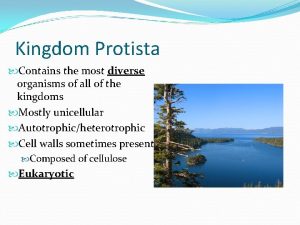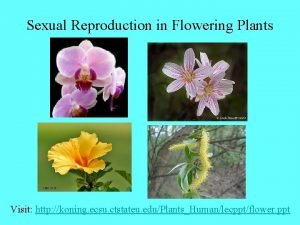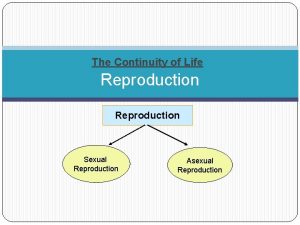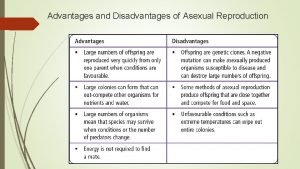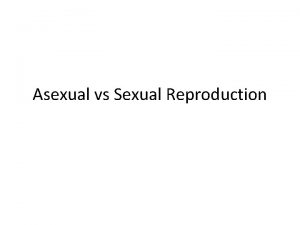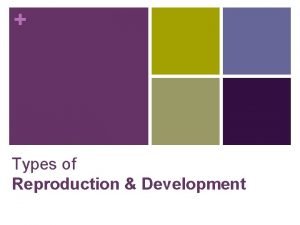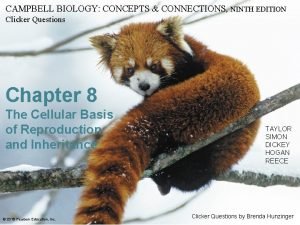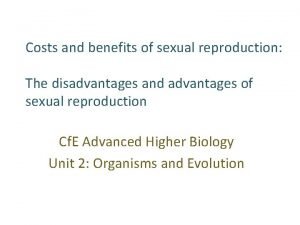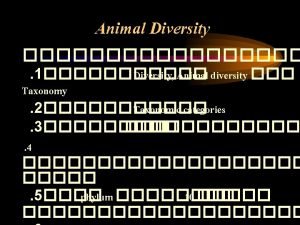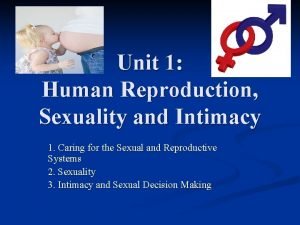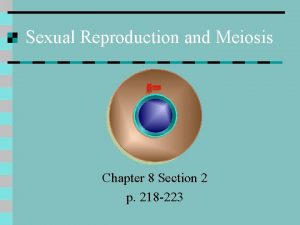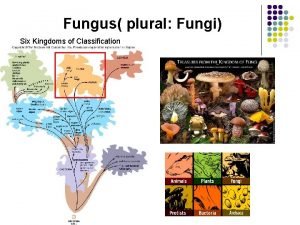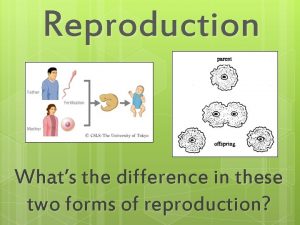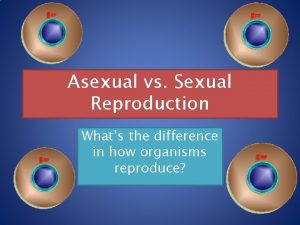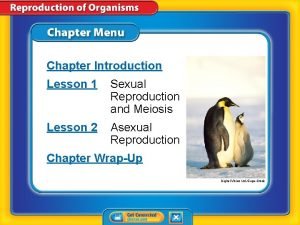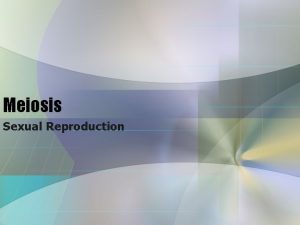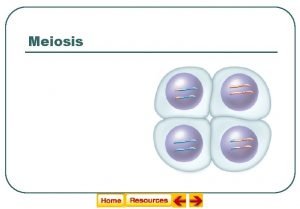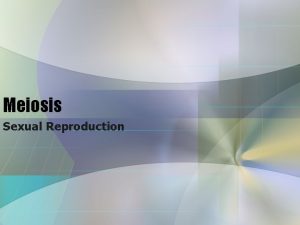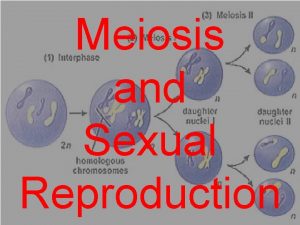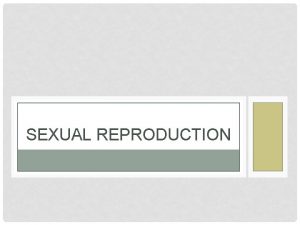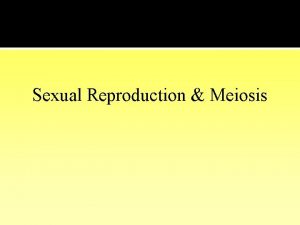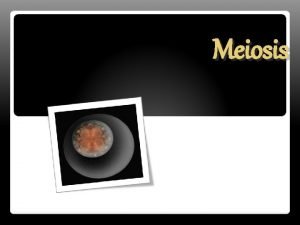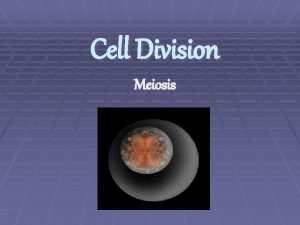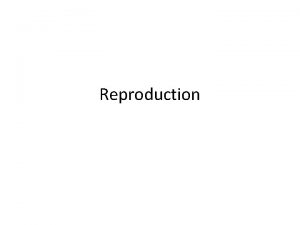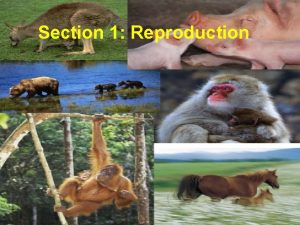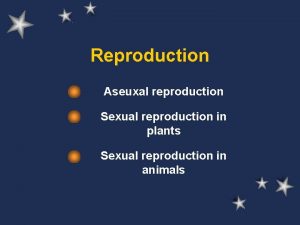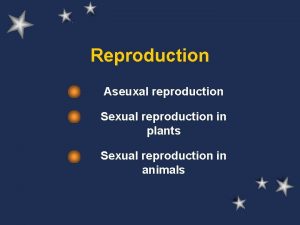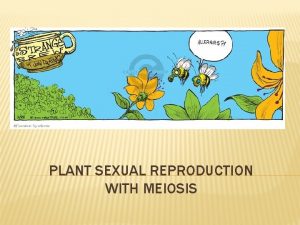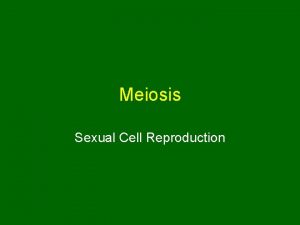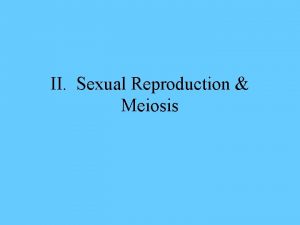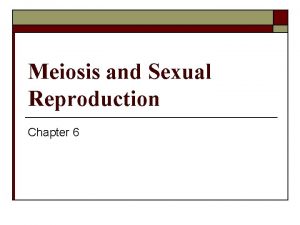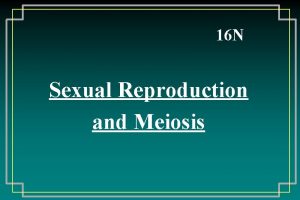Meiosis Meiosis occurs in sexual reproduction when a





























- Slides: 29

Meiosis

Meiosis occurs in sexual reproduction when a diploid germ cell (2 n) produces four haploid daughter cells (n) that can mature to become gametes (sperm or egg).

Meiosis Goal: Reduce genetic material by half Why? n (mom) + n (dad) = 2 n (offspring with variation) from mom from dad child too much! meiosis reduces genetic content Just right!

Eye color Dad #1 Mom #1 Blue Green Homologous chromosomes (1 from each parent) have the same genes on them but each allele could be different. Examples: Brown hair versus Blond hair, Green eyes versus Brown Eyes

Meiosis: Cell division in two parts Sister chromatids separate Homologous chromosomes separate Meiosis I Gamete formed Meiosis II (reduction Division 2 n to n) Diploid 2 n Haploid n Sister chromatids separate Haploid n Result: one copy of each chromosome in a gamete.

Interphase occurs before meiosis I. (G 1, S, and G 2)

Meiosis I : the reduction division Spindle fibers Nucleus Prophase I (early) (diploid) Prophase I (late) (diploid) Metaphase I (diploid) Nuclear envelope Anaphase I (diploid) Telophase I (diploid)

Meiosis : Prophase I 1. Homologous chromosomes pair 2. Non-sister Chromatids cross. (Crossing over) - Creates variation 3. Chromatin condenses to form chromosomes. 4. Spindle apparatus forms. 5. Nuclear envelope fragments. 6. Centrioles move to opposite poles Note: In Mitosis, homologs do NOT pair and NO crossing over occurs.

Crossing over occurs in prophase 1 Mom Dad Chismata Tetrad Synapsis: when homologous chromosomes pair up closely Mom and dad’s genes mix (creating variation)

Metaphase I Homologous hromosome pairs align along the equator of the cell. (metaphase plate) Spindle fibers attach to the centromeres of the chromosomes on their side only. Independent assortment occurs during metaphase I giving even more variation. Note: In mitosis all individual chromosomes align, however in meiosis chromosomes line up in pairs.

Independent assortment: homologous chromosomes randomly align on the metaphase plate during metaphase 1. All mom on one side and all dad on one side Mom is blue Dad is red 2 n = 4 n=2 1 mom on one side and 1 dad on the same side

Anaphase I Homologous Chromosomes separate and move to opposite poles. Sister chromatids remain Attached at their centromeres Note: In mitosis, sister chromatids separate, however, in meiosis, homologous chromosomes separate.

Telophase I Nuclear envelopes reassemble. Spindle apparatus disappears. Depending on the cell, chromosomes may or may not uncoil. Note: The nuclei that forms contain half of the cell’s chromosomes, which remain duplicated. In mitosis, each nucleus contains a full complement of DNA and the sister chromatids are in separate nuclei.

Cytokinesis divides cell into two. Cells are haploid (n) Note: In Mitosis, the daughter cells are still diploid (2 N)

Meiosis II Gene X Sister chromatids carry identical genetic information. Meiosis II produces gametes with one copy of each chromosome and thus one copy of each gene.

Meiosis II : the equational division Prophase II (haploid) Metaphase II (haploid) Anaphase II (haploid) Telophase II (haploid) Four Non-identical haploid daughter cells Meiosis II is very similar to mitosis

There is NO Interphase between Meiosis I and II

Prophase II Nuclear envelope fragments. Spindle fibers (apparatus) forms. Centrioles move to opposite poles If the chromosomes had uncoiled, they will re-condense here. Note: This is just like Mitosis. Difference: Mitosis involves 1 diploid cell, and Meiosis II involves 2 haploid cells.

Metaphase II Chromosomes align along equator of cell. The spindle fibers are attached to opposite sides of the centromeres. Note: This is just like Mitosis. Difference: Mitosis involves 1 diploid cell, and Meiosis II involves 2 haploid cells.

Anaphase II Sister chromatids separate and move to opposite poles. Notice the sister chromatids are not genetically identical, Why? Note: This is just like Mitosis. Difference: Mitosis involves 1 diploid cell, and Meiosis II involves 2 haploid cells.

Telophase II Nuclear envelope assembles. Chromosomes unravel. Spindle apparatus disappears. Note: This is just like Mitosis. Difference: Mitosis involves 1 diploid cell, and Meiosis II involves 2 haploid cells.

Both cells undergo Cytokinesis and divide in two.

Results of meiosis • Four genetically different haploid cells • Variation • Crossing over (prophase I) • Independent assortment (metaphase I) • Could be 4 Sperm • Could be an egg • Could be a spore if you are a plant • One copy of each chromosome in each cell. • n=23 (for a human)

“Putting It All Together” – Meiosis and the randomness of Fertilization is how Sexual Reproduction produces Variation Dad n=23 2 n=46 YOU n=23 Mom (a little like your mom a little like your dad)

What Meiosis is About Meiosis allows the creation of unique individuals through sexual reproduction. It provides the variation that allows natural selection to work on in order to allow evolution to occur

Comparing Mitosis to Meiosis Type of reproduction Asexual Sexual


Somatic cells (diploid) Interphase ◦ G 1 ◦ S ◦ G 2 M phase ◦ Mitosis Prophase Metaphase Anaphase Telophase o Cytokinesis 2 diploid somatic daughter cells return to Interphase (G 1) Germ cell (diploid) Interphase ◦ G 1 ◦ S ◦ G 2 M phase ◦ Meiosis I Prophase I Metaphase I Anaphase I Telophase I ◦ Cytokinesis 2 haploid daughter cells move on to Meiosis II Prophase II Metaphase II Anaphase II Telophase II ◦ Cytokinesis 4 haploid gametes used or reabsorbed. Do NOT return to Interphase.

Mistakes in Meiosis: Nondisjunction occurs when homologous chromosomes (Anaphase I) or sister chromatids (Anaphase II) do not separate producing sperm or egg that does not have the normal number of chromosomes (23) Notice that none of the gametes are normal Notice that two of the gametes are normal and two are not
 Asexualk
Asexualk Sexual and asexual reproduction in animals venn diagram
Sexual and asexual reproduction in animals venn diagram Sexual and asexual reproduction venn diagram
Sexual and asexual reproduction venn diagram Chapter 10 section 3 gene linkage and polyploidy
Chapter 10 section 3 gene linkage and polyploidy Section 1 meiosis
Section 1 meiosis Anaphase
Anaphase Which kingdom is most diverse
Which kingdom is most diverse Sexual reproduction
Sexual reproduction Sexual or asexual reproduction
Sexual or asexual reproduction Disadvantages of sexual reproduction
Disadvantages of sexual reproduction Define sexual reproduction
Define sexual reproduction Sarcodines
Sarcodines Sexual or asexual reproduction
Sexual or asexual reproduction External fertilization
External fertilization Chromosomes in organisms
Chromosomes in organisms Campbell biology concept check answers
Campbell biology concept check answers Disadvantage of sexual reproduction
Disadvantage of sexual reproduction Asexual reproduction
Asexual reproduction The taxonomy of the domestic dog and humans
The taxonomy of the domestic dog and humans Reproduction in humans
Reproduction in humans Sexual reproduction
Sexual reproduction Plural fungus
Plural fungus Difference of sexual and asexual reproduction
Difference of sexual and asexual reproduction Whats sexual reproduction
Whats sexual reproduction Parthenogenesis in mammals
Parthenogenesis in mammals Requires two parents
Requires two parents Sexual and asexual reproduction in animals venn diagram
Sexual and asexual reproduction in animals venn diagram Whats sexual reproduction
Whats sexual reproduction Reproduction of organisms
Reproduction of organisms Site:slidetodoc.com
Site:slidetodoc.com






